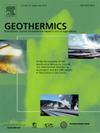Improving photovoltaic Panels by utilizing ground-coupled heat exchangers: Insights and technological advances
IF 3.5
2区 工程技术
Q3 ENERGY & FUELS
引用次数: 0
Abstract
The continuous rise in energy demand and growing environmental concerns necessitate innovative approaches to optimizing renewable energy technologies. Among these, photovoltaic (PV) panels play a pivotal role but suffer efficiency losses due to surface overheating. Ground-coupled heat exchangers (GHEs) have emerged as a promising solution, leveraging geothermal energy to regulate PV panel temperatures.
This review explores the application of GHEs for PV cooling, focusing on technical advancements, operational parameters, and soil-related influences. Key aspects analyzed include GHE design, working fluid characteristics, mass flow rates, and pipe material properties, all of which critically impact cooling efficiency and energy output. Recent studies indicate that GHE systems can reduce surface temperatures by 20 °C–25 °C and enhance thermal and electrical efficiency by 20 %, respectively. Design innovations, such as vertical and spiral configurations and nanofluid-enhanced working fluids, demonstrate significant performance improvements.
However, several challenges persist, including installation complexities, maintenance difficulties, and soil-dependent variability. This review also examines the economic and environmental feasibility of GHEs, emphasizing their integration with renewable energy systems for sustainable development. Future research directions include optimizing GHE designs, employing artificial intelligence for performance prediction, and exploring cost-effective materials and configurations.
By addressing current limitations, GHEs can significantly enhance PV efficiency, reduce carbon footprints, and promote the broader adoption of renewable energy technologies. This comprehensive review aims to guide researchers and practitioners toward the innovative deployment of GHEs in solar energy applications.
利用地面耦合热交换器改进光伏板:见解和技术进步
能源需求的持续增长和日益增长的环境问题需要创新方法来优化可再生能源技术。其中,光伏(PV)面板发挥着关键作用,但由于表面过热而导致效率损失。地面耦合热交换器(GHEs)已经成为一种很有前途的解决方案,利用地热能来调节光伏板的温度。本文探讨了温室气体在光伏冷却中的应用,重点介绍了技术进步、操作参数和与土壤有关的影响。分析的关键方面包括GHE设计、工作流体特性、质量流量和管道材料特性,所有这些都对冷却效率和能量输出有重要影响。最近的研究表明,GHE系统可以将表面温度降低20°C - 25°C,并将热效率和电效率分别提高20%。设计创新,如垂直和螺旋配置以及纳米流体增强工作流体,显示出显著的性能改进。然而,仍然存在一些挑战,包括安装复杂性、维护困难和土壤依赖性的可变性。本报告还审查了温室气体排放系统的经济和环境可行性,强调将其与可再生能源系统结合起来促进可持续发展。未来的研究方向包括优化GHE设计,利用人工智能进行性能预测,以及探索具有成本效益的材料和配置。通过解决目前的限制,温室气体排放系统可以显著提高光伏发电效率,减少碳足迹,并促进可再生能源技术的广泛采用。这篇综合综述旨在指导研究人员和实践者在太阳能应用中创新地部署温室气体。
本文章由计算机程序翻译,如有差异,请以英文原文为准。
求助全文
约1分钟内获得全文
求助全文
来源期刊

Geothermics
工程技术-地球科学综合
CiteScore
7.70
自引率
15.40%
发文量
237
审稿时长
4.5 months
期刊介绍:
Geothermics is an international journal devoted to the research and development of geothermal energy. The International Board of Editors of Geothermics, which comprises specialists in the various aspects of geothermal resources, exploration and development, guarantees the balanced, comprehensive view of scientific and technological developments in this promising energy field.
It promulgates the state of the art and science of geothermal energy, its exploration and exploitation through a regular exchange of information from all parts of the world. The journal publishes articles dealing with the theory, exploration techniques and all aspects of the utilization of geothermal resources. Geothermics serves as the scientific house, or exchange medium, through which the growing community of geothermal specialists can provide and receive information.
 求助内容:
求助内容: 应助结果提醒方式:
应助结果提醒方式:


